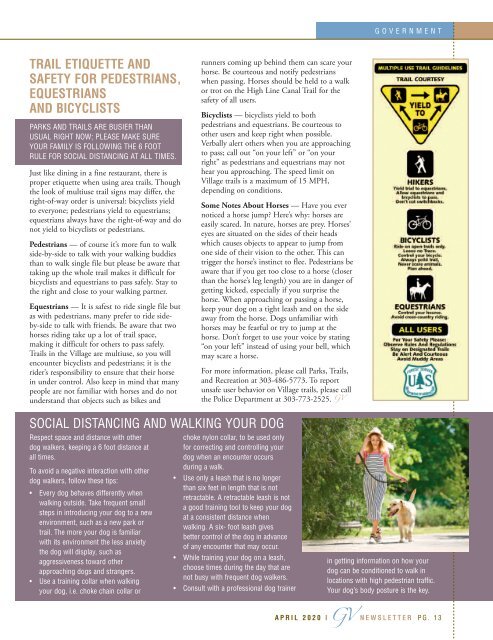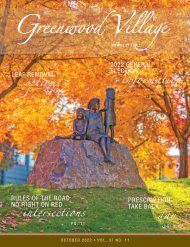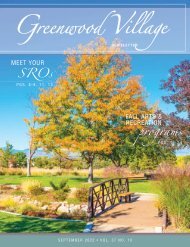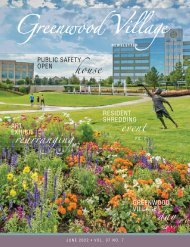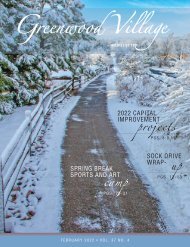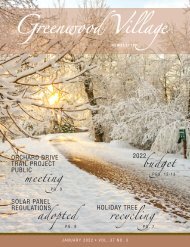April Newsletter
You also want an ePaper? Increase the reach of your titles
YUMPU automatically turns print PDFs into web optimized ePapers that Google loves.
GOVERNMENT<br />
TRAIL ETIQUETTE AND<br />
SAFETY FOR PEDESTRIANS,<br />
EQUESTRIANS<br />
AND BICYCLISTS<br />
PARKS AND TRAILS ARE BUSIER THAN<br />
USUAL RIGHT NOW; PLEASE MAKE SURE<br />
YOUR FAMILY IS FOLLOWING THE 6 FOOT<br />
RULE FOR SOCIAL DISTANCING AT ALL TIMES.<br />
Just like dining in a fine restaurant, there is<br />
proper etiquette when using area trails. Though<br />
the look of multiuse trail signs may differ, the<br />
right-of-way order is universal: bicyclists yield<br />
to everyone; pedestrians yield to equestrians;<br />
equestrians always have the right-of-way and do<br />
not yield to bicyclists or pedestrians.<br />
Pedestrians — of course it’s more fun to walk<br />
side-by-side to talk with your walking buddies<br />
than to walk single file but please be aware that<br />
taking up the whole trail makes it difficult for<br />
bicyclists and equestrians to pass safely. Stay to<br />
the right and close to your walking partner.<br />
Equestrians — It is safest to ride single file but<br />
as with pedestrians, many prefer to ride sideby-side<br />
to talk with friends. Be aware that two<br />
horses riding take up a lot of trail space,<br />
making it difficult for others to pass safely.<br />
Trails in the Village are multiuse, so you will<br />
encounter bicyclists and pedestrians; it is the<br />
rider’s responsibility to ensure that their horse<br />
in under control. Also keep in mind that many<br />
people are not familiar with horses and do not<br />
understand that objects such as bikes and<br />
runners coming up behind them can scare your<br />
horse. Be courteous and notify pedestrians<br />
when passing. Horses should be held to a walk<br />
or trot on the High Line Canal Trail for the<br />
safety of all users.<br />
Bicyclists — bicyclists yield to both<br />
pedestrians and equestrians. Be courteous to<br />
other users and keep right when possible.<br />
Verbally alert others when you are approaching<br />
to pass; call out “on your left” or “on your<br />
right” as pedestrians and equestrians may not<br />
hear you approaching. The speed limit on<br />
Village trails is a maximum of 15 MPH,<br />
depending on conditions.<br />
Some Notes About Horses — Have you ever<br />
noticed a horse jump? Here’s why: horses are<br />
easily scared. In nature, horses are prey. Horses’<br />
eyes are situated on the sides of their heads<br />
which causes objects to appear to jump from<br />
one side of their vision to the other. This can<br />
trigger the horse’s instinct to flee. Pedestrians be<br />
aware that if you get too close to a horse (closer<br />
than the horse’s leg length) you are in danger of<br />
getting kicked, especially if you surprise the<br />
horse. When approaching or passing a horse,<br />
keep your dog on a tight leash and on the side<br />
away from the horse. Dogs unfamiliar with<br />
horses may be fearful or try to jump at the<br />
horse. Don’t forget to use your voice by stating<br />
“on your left” instead of using your bell, which<br />
may scare a horse.<br />
For more information, please call Parks, Trails,<br />
and Recreation at 303-486-5773. To report<br />
unsafe user behavior on Village trails, please call<br />
the Police Department at 303-773-2525. GV<br />
SOCIAL DISTANCING AND WALKING YOUR DOG<br />
Respect space and distance with other<br />
dog walkers, keeping a 6 foot distance at<br />
all times.<br />
To avoid a negative interaction with other<br />
dog walkers, follow these tips:<br />
• Every dog behaves differently when<br />
walking outside. Take frequent small<br />
steps in introducing your dog to a new<br />
environment, such as a new park or<br />
trail. The more your dog is familiar<br />
with its environment the less anxiety<br />
the dog will display, such as<br />
aggressiveness toward other<br />
approaching dogs and strangers.<br />
• Use a training collar when walking<br />
your dog, i.e. choke chain collar or<br />
choke nylon collar, to be used only<br />
for correcting and controlling your<br />
dog when an encounter occurs<br />
during a walk.<br />
• Use only a leash that is no longer<br />
than six feet in length that is not<br />
retractable. A retractable leash is not<br />
a good training tool to keep your dog<br />
at a consistent distance when<br />
walking. A six- foot leash gives<br />
better control of the dog in advance<br />
of any encounter that may occur.<br />
• While training your dog on a leash,<br />
choose times during the day that are<br />
not busy with frequent dog walkers.<br />
• Consult with a professional dog trainer<br />
in getting information on how your<br />
dog can be conditioned to walk in<br />
locations with high pedestrian traffic.<br />
Your dog’s body posture is the key.<br />
APRIL 2020 | GV NEWSLETTER PG. 13


